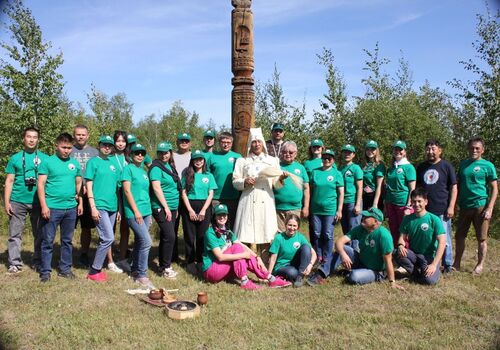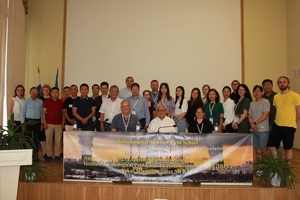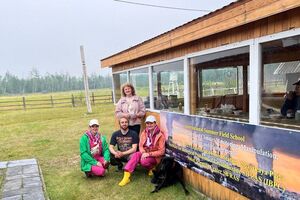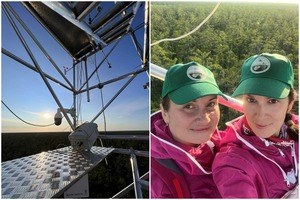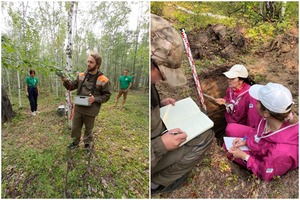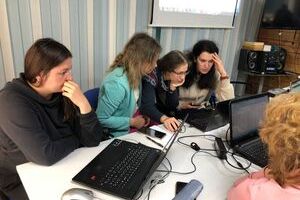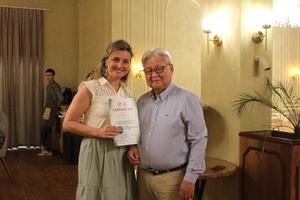The event was part of the vital innovative project of national importance (VIP NI) “Unified national system for monitoring climate active substances”, in which some KarRC RAS research units are among partners.
The target audience of this international field school is scientists dealing with the problem of monitoring of climate-active substances and transboundary carbon regulation. The aim is to provide researchers with a broad understanding of the decarbonization issue, to help put the knowledge of how to organize a national system of carbon testing sites and farms into practice, and to use scientific diplomacy to promote communication between science, the society, and stakeholders.
The summer school opened with a plenary session, in which leading scientists from Russia, Japan, Taiwan, China, and the USA made presentations on the problem of greenhouse gases in terrestrial ecosystems in the context of natural environment and climate change.
The participants of the field agenda were 35 specialists from different regions of Russia and China. During introductions, the scientists told about their organizations and research specifics. The Karelian delegation included staff from two laboratories of the Forest Research Institute KarRC RAS, which implements the project “Designing a system for monitoring the carbon budget in forests of Eastern Fennoscandia” within the abovementioned VIP NI.
Vladislava Pridacha, Head of the Laboratory for Woody Plant Physiology and Cytology, informed that eco-physiological studies of the carbon and water metabolism of woody plants have been conducted at the Institute for more than 40 years. Their relevance today arises from the need to assess the resilience of forest ecosystems to changes in the natural environment and climate.
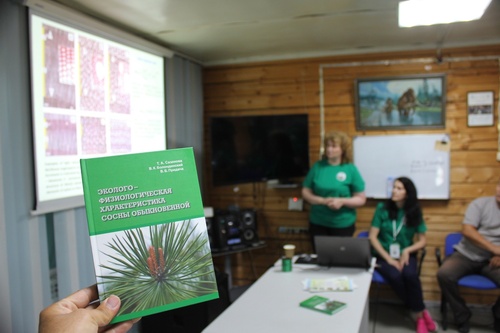
The results of studies by physiologists are summarized in the monograph "Eco-physiological characteristics of Scots pine"
The factor determining the transformation of forest communities in most of the boreal biome is logging. It causes substantial alterations in the forest cover and soils, in microclimatic conditions, and in the water regime of soils. A consequence of that is intensive loss of carbon from the forest ecosystems.
Karelian scientists revealed the effects of clear-cutting on the parameters of carbon-, water-, and mineral exchange and hydraulic characteristics in the main tree species that form forests in our region: pine, birch, aspen, and alder. This helped them identify differences between the species in ÑÎ2/Í2Î gas exchange adaptation and the different hydraulic behavior strategies of deciduous and coniferous tree species in response to changes in the habitat.
– This is important because the increasing recurrence of heat and drought periods can make pine and aspen more competitive. They form a more efficient and safer hydraulic structure, which provides a higher photosynthetic productivity under drought conditions. Birch, on the other hand, is more vulnerable in dry conditions," Vladislava Pridacha explained.
The researchers also estimated the components of carbon metabolism in woody plants (photosynthesis and leaf respiration) and soil cover (soil respiration) in a clear-cut mid-boreal bilberry-type pine forest site. The findings for a clear-cut site in southern Karelia were intra-seasonal variability and, on the contrary, similarity of long-term mean annual values of carbon metabolism in woody plants and soil, as well as a predominance of CO2 absorption over its emission.
These results can be used to predict the effects of human impact on carbon exchange in forest vegetation and soils.
Elena Moshkina, Researcher from the Forest Soil Science Laboratory, told about studies on carbon dioxide emission from soil surface. The laboratory has been studying this topic since 2016. The data are needed to determine the carbon balance in terrestrial ecosystems.
– Soil respiration is the largest flux of carbon dioxide from forest ecosystems to the atmosphere, turning them into either a sink or a source of carbon. It falls into two components: the autotrophic one relates to living plants - this is root respiration, and the heterotrophic one relates to soil micro-, meso- and macrofauna. E.g., we computed the contributions of autotrophic and heterotrophic respiration in mid-boreal forests. It turned out that the contribution of root respiration is also significant, accounting for 24-45% of the total volume depending on the season. The seasonal pattern of soil CO2 emissions is largely determined by air and soil temperature, - Elena Moshkina noted.
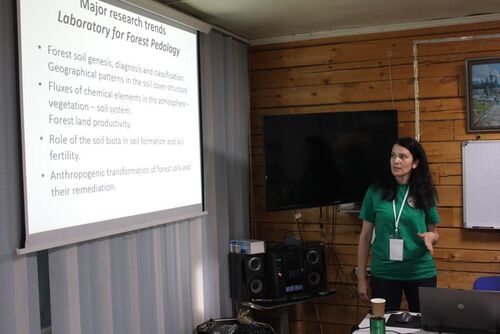
Elena Moshkina, Researcher at the Forest Research Institute KarRC RAS, talking about the studies carried out by the Forest Soil Science Laboratory
The researchers also estimated the CO2 flux from soil surface in winter, which amounted to 15-24% of the annual CO2 emissions. It was concluded that winter fluxes must not be neglected when calculating the ecosystem's carbon balance.
Previously, the scientists have also estimated the volumes of CO2 emissions from downed deadwood in old-growth forests. The share of ÑÎ2 emission from downed and hanging deadwood proved to be substantial, amounting to 10-15% of the growing season’s total ÑÎ2 emission from the soil surface in a bilberry-type spruce stand. The study dealt with bark fragmentation and mineralization processes. As a result, new methodological approaches to estimating the respiration rates in components of downed tree trunks – bark and wood, were designed.
The scientists commented that the program of practical sessions and lectures was tailored as much as possible to the participants' needs.In particular, in connection with the establishment of a testing ground in our republic, specialists in Karelia were curious to learn about the operation of the CO2 flux measuring system at the Spasskaya Pad research station. Its equipment includes a series of Eddy Covariance towers ranging in height from 20 to 32 meters, featuring state-of-the-art instrumentation and software.
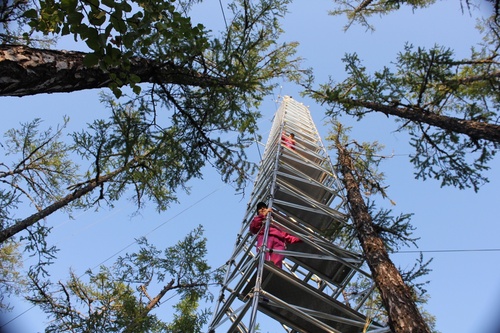
The station’s equipment includes special towers
Throughout the week, scientists shared expertise and collaboratively conducted research on greenhouse gas fluxes and carbon pools, plant gas exchange and emissions from soil, science diplomacy, and were familiarized with new research methods, state-of-the-art instruments and measuring systems.
In addition to scientific activities, the participants of the school were offered an extensive cultural program. It included an overview of the socio-economic development of Russian and Chinese regions, their cultural and natural attractions, folk songs, dances and games. For example, participants from Karelia brought over ethnic costumes, baked traditional Karelian “pies for the son-in-law” (keitinpiiroa) for their colleagues and arranged a kruuga – Karelian folk round dance.
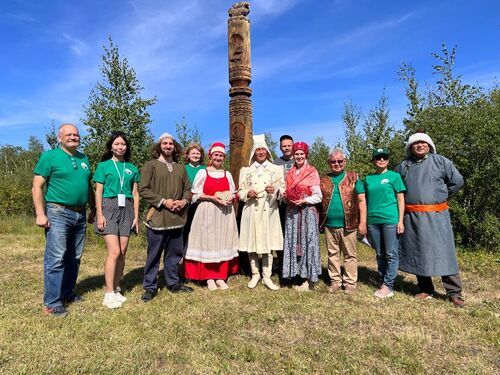
Karelian scientists brought over ethnic costumes
As a follow-up, scientists from the Institute of Atmospheric Physics of the Chinese Academy of Sciences expressed their willingness to participate in organizing the future field school in Russia and to actively involve foreign colleagues. Next year, a Russian-Chinese international summer school is scheduled to be held in Russia for the first time.
KarRC RAs also actively promotes international contacts under the BRICS association umbrella. The international conference "Regional cooperation within BRICS: sustainable nature management – environment, education, tourism" will take place in Karelia in September.
Photos from the archives of participants of the International Summer Field School




